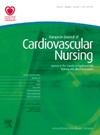心肌梗死或心房颤动后患者对针对运动恐惧症的数字集体教育的体验--一项定性试点研究
IF 2.9
3区 医学
Q2 CARDIAC & CARDIOVASCULAR SYSTEMS
引用次数: 0
摘要
背景心肌梗塞或心房颤动后的患者中普遍存在运动恐惧(运动恐惧症)。运动恐惧的产生是由于患者认为体育锻炼可能会导致再次受伤。这对他们进行体育锻炼的能力产生了负面影响,而体育锻炼是目前指南中规定的一线治疗方法。目的 探讨心肌梗死和/或心房颤动患者如何体验参与针对运动恐惧和体育锻炼的数字团体教育。方法 纳入 7 名至少在 6 个月前发生过心肌梗死和/或心房颤动并患有运动恐惧的女性(55-81 岁),即在坦帕心脏运动恐惧量表瑞典版中得分≥ 37 分。他们参加了一个基于问题学习和认知行为疗法的数字化项目,该项目通过视频会议平台进行,为期 8 周,由一名护士或理疗师负责监督。该项目涵盖了心肌梗塞、心房颤动、运动恐惧症、体育锻炼和暴露等主题。我们开发了一个带有双因素验证登录功能的数字平台,以提供教学材料,包括辅导小组情景、流媒体讲座、事实性文本和家庭作业。在为期 8 周的课程结束后,通过视频会议平台对妇女进行了个人半结构化访谈,并采用传统的定性内容分析方法对访谈记录进行了分析。初步结果 妇女们在与小组成员进行数字接触和快乐讨论后,感到自己的能力得到了增强。小组讨论的教育材料和她们自己搜索的信息让她们感到豁然开朗。根据她们的经验,运动恐惧症得到了缓解或消失。这促使妇女们根据自己的喜好积极参加体育活动。最初,她们感到了技术问题带来的压力。在视频会议平台上,辅导员细心地为妇女们提供了指导。结论 针对心肌梗死和/或心房颤动后运动恐惧症的数字团体教育在一小群妇女中是可行的、有启发性的和有力量的。运动恐惧症得到了缓解或消失。这促使她们按照自己的喜好进行体育锻炼,这对她们的康复非常重要。我们需要进行更多和更大规模的研究,以证明通过视频会议平台开展的数字集体教育项目能否减轻运动恐惧,并促进心肌梗死或心房颤动后的体育锻炼。本文章由计算机程序翻译,如有差异,请以英文原文为准。
Patients' experiences of a digital group education targeting kinesiophobia after myocardial infarction or atrial fibrillation - a qualitative pilot study
Background Fear of movement (kinesiophobia) is common among patients after a myocardial infarction or atrial fibrillation. The kinesiophobia is developed due to the patients’ beliefs that physical activity may cause re-injury. This negatively affects their ability to perform physical activity which is stated as the first line treatment in present guidelines. Purpose To explore how patients with myocardial infarction and/or atrial fibrillation experience participation in a digital group education targeting kinesiophobia and physical activity. Methods Seven women (55-81 years) with myocardial infarction and/or atrial fibrillation that had occurred at least 6 months earlier, and kinesiophobia, i.e., score of ≥ 37 on the Tampa Scale of Kinesiophobia Swedish Version for the Heart, were included. They took part in a digital program that was based on problem-based learning and cognitive behavioural therapy and delivered via a video conferencing platform over 8 weeks and supervised by a nurse or physiotherapist. The program covered topics such as myocardial infarction, atrial fibrillation, kinesiophobia, physical activity, and exposure. A digital platform with two-factor authentication for login was developed to provide educational materials, including tutorial group scenarios, streamed lectures, factual texts, and homework assignments. Individual semi-structured interviews were conducted with the women via a video conferencing platform after the 8-week program and transcripts were analysed using conventional qualitative content analysis. Preliminary results The women felt empowered after the digital encounters and joyful discussions with the group members. The educational materials and their own search for information, which was discussed in the group made them feel enlightened. The kinesiophobia was relieved or gone according to their experiences. This promoted the women to be physically active based on their own preferences. Initially, experiences of stress due to technical problems were felt. The tutor was attentive and enabling in guiding the women during the meetings on the video conferencing platform. Conclusions A digital group education targeting kinesiophobia after myocardial infarction and/or atrial fibrillation was experienced as feasible, enlightening, and empowering in a small group of women. The kinesiophobia was relieved or gone. This promoted them to perform physical activity as they preferred, and which is important for their recovery. More and larger studies are needed to show if a digital group educational program via a video conferencing platform can reduce kinesiophobia and promote physical activity after myocardial infarction or atrial fibrillation.
求助全文
通过发布文献求助,成功后即可免费获取论文全文。
去求助
来源期刊

European Journal of Cardiovascular Nursing
CARDIAC & CARDIOVASCULAR SYSTEMS-NURSING
CiteScore
5.10
自引率
10.30%
发文量
247
审稿时长
6-12 weeks
期刊介绍:
The peer-reviewed journal of the European Society of Cardiology’s Council on Cardiovascular Nursing and Allied Professions (CCNAP) covering the broad field of cardiovascular nursing including chronic and acute care, cardiac rehabilitation, primary and secondary prevention, heart failure, acute coronary syndromes, interventional cardiology, cardiac care, and vascular nursing.
 求助内容:
求助内容: 应助结果提醒方式:
应助结果提醒方式:


